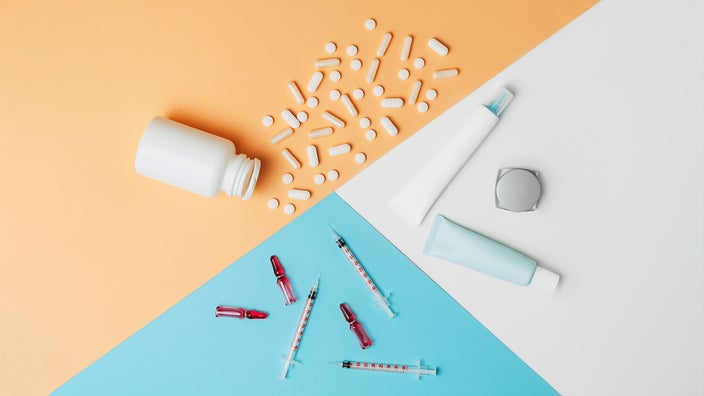
Bioidentical Hormone Replacement Therapy for Menopause: Safety, Uses, and Cost
Key takeaways:
Bioidentical hormones are lab-made hormones that are chemically similar to the hormones in your body. They’re made from a plant steroid found in soy and wild yams.
There are FDA-approved bioidentical hormone products available, including estradiol (Estrace, Climara, Vivelle) and progesterone (Prometrium).
Many compounded hormones are also considered to be bioidentical. These are hormones made just for you. But they aren’t FDA-approved and can vary in quality.

Hot flashes, brain fog, and sleeping problems — the telltale signs of menopause. For many women, these symptoms can greatly impact their quality of life. If this sounds like you, chances are you’ve come across bioidentical hormones while exploring options to provide relief.
Over the years, bioidentical hormones have been promoted as a safer alternative to conventional hormone replacement options. And they’ve been touted as a way to delay the effects of aging, too. But what exactly are bioidentical hormones, and are they really better? Keep reading to learn more.
What are bioidentical hormones?
While it’s not an official term, “bioidentical” is typically used to describe hormones that are chemically similar to the ones made by your body. This type of hormone is often promoted as being more natural. But you may be surprised to learn that bioidentical hormones are made in a lab.
Bioidentical hormones are typically made from a plant steroid called diosgenin. Diosgenin is extracted from soy or wild yams. However, that doesn’t mean you can consume soy or wild yams and get the same benefit. That’s because diosgenin needs to be chemically converted in a lab first. But after it is, these hormones typically look like and have similar effects as the hormones in your body.
Compounded bioidentical hormones
When bioidentical hormones are discussed, this is usually in reference to compounded hormones. Compounded bioidentical hormones are made just for you by a compounding pharmacy. They can be made into a variety of dosage forms, like vaginal suppositories, oral capsules, and topical creams. And their strengths and ingredients can be customized to meet your individual needs.
Examples of compounded bioidentical hormones include:
Estrogens (estriol, estradiol, and estrone)
Progesterone
Testosterone
Dehydroepiandrosterone (DHEA; prasterone)
A compounded hormone product may contain one hormone, or a combination of a few different hormones. For example, some healthcare providers will combine more than one type of estrogen together. And they may add progesterone, too.
Compounded bioidentical hormones may be used if you’re unable to take an FDA-approved product. This might be due to an allergy (like peanut oil) or if you’re unable to find relief with a commercial product. In some cases, your healthcare provider might prefer a compounded product and try that first.
Keep in mind: Compounded medications aren’t FDA-approved. So, their safety and effectiveness haven’t been reviewed by the FDA. Because of this, experts don’t recommend them. But if you’re looking for an FDA-approved bioidentical hormone, there are many options available.
FDA-approved bioidentical hormones
There are also several FDA-approved hormone products that meet the definition of “bioidentical.” These include a variety of tablets, creams, inserts, and more to help relieve certain menopause symptoms.
Examples of FDA-approved bioidentical hormones include:
| Route | Type | Brand name(s) |
|---|---|---|
| Oral | Estradiol tablet | Estrace |
| Estradiol/progesterone capsule | Bijuva | |
| Vaginal | Estradiol vaginal cream | Estrace |
| Estradiol vaginal ring | Femring, Estring | |
| Estradiol vaginal insert | Vagifem, Yuvafem, Imvexxy | |
| DHEA vaginal insert | Intrarosa | |
| Topical | Estradiol patch | Climara, Alora, Vivelle, Vivelle-Dot, Dotti |
| Estradiol gel | Divigel, Elestrin, EstroGel | |
| Estradiol spray | Evamist | |
| Injection | Estradiol injection | Depo-Estradiol |
Progesterone (Prometrium) is also available. Some healthcare providers may prescribe it off-label to treat menopause symptoms. But one of its FDA-approved uses is to protect the uterus if you’re also taking estrogen. More on that later.
Bioidentical vs. synthetic hormones
The term “synthetic” is typically used to describe hormones that aren’t bioidentical. One example is Premarin (conjugated estrogens), a synthetic hormone product that was first approved to treat menopause symptoms in 1942. It contains a mixture of estrogens from the urine of pregnant horses.
Synthetic hormones were put under the spotlight in 2002, when the initial results of the Women’s Health Initiative (WHI) were released. This was the largest women’s health prevention study ever conducted. The findings showed that hormone therapy in postmenopausal women could raise the risk of breast cancer, blood clots, heart disease, and other conditions.
Since then, bioidentical hormones — specifically compounded products — have been promoted as a safer alternative. However, there’s no definitive evidence to suggest they’re safer or more effective.
What are bioidentical hormones used for?
As you get older, your hormone levels decline. These changes are usually most significant during menopause, especially with estrogen and progesterone. Lower levels of these hormones can result in symptoms like hot flashes, sleeping problems, and vaginal dryness.
Hormones — including bioidentical hormones — are used to replace these hormones in your body to help provide relief. This is referred to as hormone replacement therapy (HRT). Sometimes the term “BHRT” is used when specifically talking about bioidentical hormones.
Bioidentical hormones are used to treat a number of menopause symptoms, including:
Hot flashes
Brain fog
Sleeping problems
Irritability
Vaginal dryness
Pain during sex
Bladder problems
Some hormone products are also used to help prevent certain medical conditions that are influenced by hormone levels, like osteoporosis.
Depending on your specific symptoms, your healthcare provider will recommend the best option for you. For example, vaginal estradiol may work best if you’re experiencing vaginal symptoms. And some healthcare providers may treat other symptoms, like low libido, with testosterone. But this is considered an off-label use for FDA-approved testosterone products.
Bioidentical hormones aren’t just for women. They’re used in men, too. That’s because age and other factors can cause testosterone levels in men to decline. Low testosterone can cause symptoms like hair loss, erectile dysfunction, and mood changes. Read more about testosterone replacement options here.
Side effects of bioidentical hormone replacement therapy
As with most medications, bioidentical hormones can cause side effects. Some examples of side effects you may experience with estrogen and progesterone replacement include:
Many of the side effects listed above should subside over time. However, hormone replacement can also cause some serious side effects that require medical attention. These risks can vary based on the hormone regimen, how it’s given, and how long you take it.
Serious side effects include:
Call 911 or get immediate medical attention if you develop symptoms like chest pain that doesn’t go away, shortness of breath, or slurred speech. And make sure that you’re performing regular self-exams to check for lumps in your breasts.
If you still have a uterus, using estrogen by itself can raise the risk of uterine cancer. Taking progesterone with it may help lower this risk. But if you’ve had a hysterectomy (surgery that removes the uterus), using estrogen by itself is typically OK.
Are bioidentical hormones safe?
The WHI findings highlighted some of the serious risks associated with HRT. Since then, researchers have learned more about its potential benefits and risks.
Today, experts agree that most healthy women who are within 10 years of menopause (and up to age 59) can benefit from FDA-approved HRT to provide symptom relief. And there are ways to navigate some of these risks, like using the lowest dose for the shortest amount of time, and opting for local vaginal estradiol instead.
Your healthcare provider will weigh the benefits and risks of your specific situation to decide if hormone therapy is right for you.
As mentioned earlier, experts don’t recommend compounded hormones. That’s because they haven’t been evaluated by the FDA. And because they’re made just for you, quality can vary by pharmacy. In fact, the FDA has tested compounded hormones from multiple pharmacies. The results showed hormone strengths ranging from less than 70% to almost 270% of what they should be.
This variability may cause the product to not work as well or cause more side effects. Yet, your healthcare provider may determine that a compounded hormone is right for you. If that’s the case, it’s important to fill your prescription at an accredited compounding pharmacy they trust.
How much does bioidentical hormone replacement therapy cost?
The cost of bioidentical hormone replacement depends on your specific regimen. For example, several FDA-approved bioidentical hormones, like Estrace, have lower-cost generic versions. Other brand-name-only products, like Bijuva, may be more expensive.
The cost of compounded bioidentical hormones can be even more varied. That’s because pricing can be different from pharmacy to pharmacy, even for a similar product. And compounded medications aren’t always covered by insurance. So, you’ll likely need to pay out-of-pocket for your prescription.
The bottom line
“Bioidentical” isn’t an official term. But it has been used to describe hormones that are chemically similar to hormones in your body. Certain FDA-approved and compounded hormone products are considered bioidentical.
There’s no definitive evidence to suggest that bioidentical hormones, especially compounded products, are safer than synthetic hormones. If you’re interested in starting HRT, talk to your healthcare provider about which option is best for you.
Why trust our experts?


References
A-S Medication Solutions. (2021). Premarin [package insert].
American College of Obstetricians and Gynecologists. (2012). Compounded bioidentical menopausal hormone therapy.
Cagnacci, A., et al. (2019). The controversial history of hormone replacement therapy. Medicina.
Files, J. A., et al. (2011). Bioidentical hormone therapy. Mayo Clinic Proceedings.
Food and Drug Administration. (2019). Menopause & hormones: Common questions.
Islam, R. M., et al. (2019). Safety and efficacy of testosterone for women: A systematic review and meta-analysis of randomised controlled trial data. The Lancet Diabetes & Endocrinology.
MedlinePlus. (2018). Estrogen and progestin (hormone replacement therapy).
MedlinePlus. (2019). Menopause.
MedlinePlus. (2020). Aging changes in hormone production.
National Academies of Sciences, Engineering, and Medicine. (2020). The clinical utility of compounded bioidentical hormone therapy: A review of safety, effectiveness, and use.
North American Menopause Society. (n.d.). Bioidentical hormone therapy.
North American Menopause Society. (n.d.). News you can use about hormone therapy.
North American Menopause Society. (n.d.). The experts do agree about hormone therapy.
Office on Women’s Health. (2020). Largest women's health prevention study ever – Women's Health Initiative.
Pinkerton, J. V. (2012). The truth about bioidentical hormone therapy. The Female Patient.
Pinkerton, J. V., et al. (2016). Update on medical and regulatory issues pertaining to compounded and FDA-approved drugs, including hormone therapy. Menopause.
Samaras, N., et al. (2014). Off-label use of hormones as an antiaging strategy: A review. Clinical Interventions in Aging.
Sites, C. K. (2008). Bioidentical hormones for menopausal therapy. Women’s Health.

























